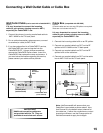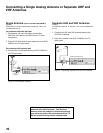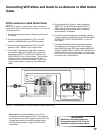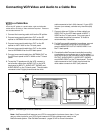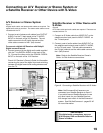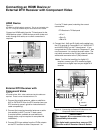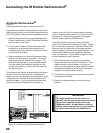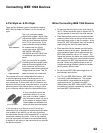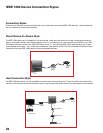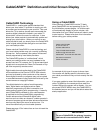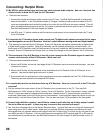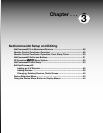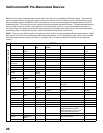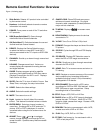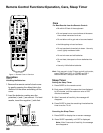
22
23
Connecting IEEE 1394 Devices
4-Pin Style vs. 6-Pin Style
There are two different types of connectors used for
IEEE 1394 terminals and cables, a 4-pin and a 6-pin
style.
The 4-pin connector sends
digital audio signals, digital video
signals and digital control signals
back and forth between devices.
Your TV has two or three 4-pin
type connection jacks available.
All models have two inputs
on the back panel. WS-55615,
WS-55615A. WS-65615.
WS-65615A and WS-73615 have
an additional input on the front
panel.
The 6-pin connector is capable
of sending the same digital audio,
video and control signals as the
4-pin connector, but the 6-pin
connector is also able to send low
voltage electrical power. This TV
does not have 6 pin connectors.
The purpose of this low voltage electrical power is
to provide operating power to a device that is not
connected directly to the household AC power such
as a camcorder. A device with a 6-pin connector can
send this electrical power to another device, or receive
electrical power from another device, or simply use a
6-pin connector without using the two additional pins.
A 6-pin connector cannot be
connected directly to a 4-pin
jack, and vice versa. Instead,
you will need to obtain a 6-pin to
4-pin adaptor or adaptor cable.
These cables are available from
electronic and computer stores.
If you connect a 6-pin device to the TV (such as a
camcorder) that is designed to receive electrical power
from another 6-pin device, you will need to connect
the camcorder directly to the household AC, or use the
camcorder’s battery for power. If this is not possible,
then the camcorder will need to be connected directly
to another 6-pin device in the network that can provide
the electrical power.
6 pin to 4 pin adaptor
4 pin connector
6 pin connector
When Connecting IEEE 1394 Devices
• Do not loop the last device in the chain back to
the TV. When the device chain is looped, the TV
may not be able to work with the other devices.
• Place devices that have only a mechanical (two-
position) power switch at the end of the chain or
leave the power switch in the On position. When
turned Off, IEEE 1394 signals may not be able to
pass through the device to other devices.
• Place devices with the slowest communication
speed at the end of the chain. Sometimes the
communication speed will be marked near the
IEEE 1394 connector with an “S” number. The
higher the number, the faster the communication
speed. Devices with slow communication speed
can interfere with IEEE 1394 signals from faster
devices. When using NetCommand to set up
a digital recording between a faster and slower
device, select “Record Later”.
• Do not use an IEEE 1394 cable longer than 15
feet between each device.
• This TV is an IEEE 1394a Device. IEEE 1394b
is currently under development. This system
will provide for longer distances and multi-
room applications. Included in the IEEE
1394b systems are IEEE 1394a to IEEE 1394b
converters to maintain compatibility with this TV
and other IEEE 1394a devices.



